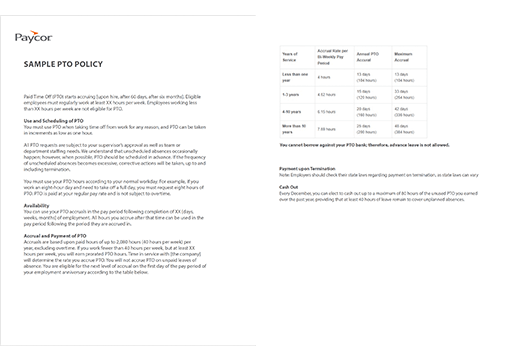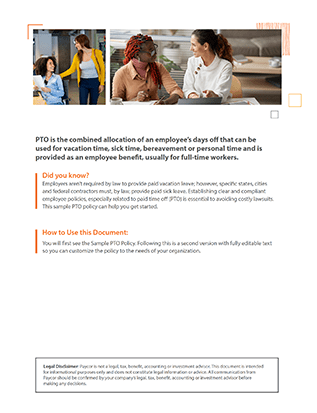Get Access to a Customizable PTO Policy
Now, more than ever, it’s essential that employers have effective PTO policies in place. Employees who aren’t getting the rest they need get burnt out, and long-term, employers risk facing staff shortages when too many employees take their vacations all at once. Whether your company has an accrual policy, banked PTO or unlimited PTO, it’s critical that a formal time off or paid leave policy is in place so that employees are aware of the rules and expectations. Too many accrued PTO days can put companies in a precarious position financially. And, if PTO is mismanaged, employers can be out of compliance with state laws. The good news is, we’ve put together a guide of everything employers need to know.
What is paid time off or PTO?
Paid time off or PTO refers to the allocation of time employees can take off work and still be paid regular wages. PTO is the combined allocation that can be used for vacation time, sick time, bereavement or personal time and is provided as an employee benefit, usually for full-time workers. PTO is often accrued over each pay period but may also be assigned at the beginning of employment.
Are Employers Required to Offer PTO?
Most employers are not required by federal law to offer PTO; however, some federal contract work requires paid time off. Some small to medium sized businesses have undocumented paid time off (PTO) policies simply because they’re not sure where to start.
Do employers have to provide PTO to contractors or part-time employees?
Under the Fair Labor Standards Act (FLSA), employers aren’t required to provide paid leave to part-time or full-time employees, but they can’t refuse to pay exempt employees for absence due to illness or disability unless they have a documented plan for paid time off specific to these absences, and those exempt employees are either not eligible yet or have used up their PTO benefits under the plan.
What are the benefits of a PTO policy?
Because PTO combines all of an employees’ time off and offers flexibility for them to use it for vacation, sickness or personal days, it’s important to have a formal PTO policy that does the following:
- Allows employers to manage unscheduled absences
- Serves as a helpful benefit for applicants and current employees.
- Gives employees clear direction on how much PTO is offered, when it starts, how it is accrued and how much can be used at one time.
- Provides terms for special circumstances (unpaid time off)
What are the laws related to PTO policies?
Employers aren’t required by law to provide paid vacation leave; however, specific states, cities and federal contractors must, by law, provide paid sick leave. As an employer, it’s important to acknowledge each state’s laws for sick leave, family leave, and PTO payout rules. PTO payout laws are for employees who have accrued time off and then leave a company before it can be used. A clearly defined paid time off policy can help with any confusion about this requirement.
PTO Policies Can Help You Remain Compliant
Establishing clear and compliant employee policies is essential to avoiding costly lawsuits. Businesses should consistently review their employee handbooks and individual policies to ensure that they are updated to reflect the latest government regulations.
If you’re starting from scratch, or if you need to update your existing policy, here are a few guidelines that can help. We’ve provided suggestions, but you can adjust hours and terminology to fit your situation.
PTO Policy Example
Paid Time Off (PTO) starts accruing [upon hire, after 60 days, after six months]. Eligible employees must regularly work at least XX hours per week. Employees working less than XX hours per week are not eligible for PTO.
Use and Scheduling of PTO
You must use PTO when taking time off from work for any reason, and PTO can be taken in increments as low as one hour.
All PTO requests are subject to your supervisor’s approval as well as team or department staffing needs. We understand that unscheduled absences occasionally happen; however, when possible, PTO should be scheduled in advance. If the frequency of unscheduled absences becomes excessive, corrective actions will be taken, up to and including termination.
You must use your PTO hours according to your normal workday. For example, if you work an eight-hour day and need to take off a full day, you must request eight hours of PTO. PTO is paid at your regular pay rate and is not subject to overtime.
Availability
You can use your PTO accruals in the pay period following completion of XX [days, weeks, months] of employment. All hours you accrue after that time can be used in the pay period following the period they are accrued in.
Accrual and Payment of PTO
Accruals are based upon paid hours of up to 2,080 hours (40 hours per week) per year, excluding overtime. If you work fewer than 40 hours per week, but at least XX hours per week, you will earn prorated PTO hours. Time in service with [the company] will determine the rate you accrue PTO. You will not accrue PTO on unpaid leaves of absence. You are eligible for the next level of accrual on the first day of the pay period of your employment anniversary according to the table below.
| Years of Service | Accrual Rate per Bi-Weekly Pay Period |
Annual PTO Accrual | Maximum Accrual |
| Less than one year | 4 hours | 13 days (104 hours) |
13 days (104 hours) |
| 1-3 years | 4.62 hours | 15 days (120 hours) |
33 days (264 hours) |
| 4-10 years | 6.15 hours | 20 days (160 hours) |
42 days (336 hours) |
| More than 10 years | 7.69 hours | 25 days (200 hours) |
48 days (384 hours) |
You cannot borrow against your PTO bank; therefore, advance leave is not allowed.
Payment upon Termination
In accordance with [state – Note that if you have locations in multiple states, this section must be carefully reviewed for accuracy] law, after [XX days, weeks, months] of employment, you will be paid for all PTO hours you accumulated but did not use if you resign, retire, or otherwise separate from the company.
Cash Out
Every December, you can elect to cash out up to a maximum of 80 hours of the unused PTO you earned over the past year, providing that at least 40 hours of leave remain to cover unplanned absences.
How to pick a PTO policy for your business
There are a few different types of PTO methods you can adopt for your business:
- Accrued PTO, which an employee builds up over time
- Banked PTO, which is distributed all at once
- Unlimited PTO, an unlimited amount of hours and days for each employee that can be defined by your company policy.
When choosing a PTO policy for your business, it’s important to consider your business’ needs during holidays and peak times. For example, it probably doesn’t make sense for a company with a high production requirement to have an unlimited PTO policy.
Paycor Can Help
With Paycor’s automated time and attendance system, employees can request time off, see how PTO they’ve accrued and easily access employer PTO policies. But that’s just the tip of the iceberg. Employees can also clock in and out, manage their schedules and view pay stubs, all while on the go. Want to learn more? Connect with a Paycor consultant.






